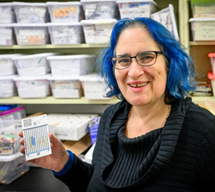Got Fakes? Paper microfluidics and the hunt for bad quality medicines

Marya Lieberman, PhD
Our Distinguished Speaker
Abstract
In low- and middle-income countries, about one in ten medicine products is substandard or falsified. In my lab, I have samples of antimalarial drugs made from starch and chalk, antibiotics “cut” with talcum powder, and chemotherapy drugs that were manufactured at half the concentration they should have been. How do these products get into the supply chain, and more importantly, how can chemists help to get them out? This talk will focus on a point-of-use testing device that my group invented twelve years ago, the paper analytical device or PAD. I’ll explain how this paper microfluidic device works and how we are implementing it with partners in sub-Saharan Africa to discover bad quality medicines.
About The Speaker
Dr. Marya Lieberman enjoys making stained glass, cooking, and solving fiendish cryptic crosswords. She loves chemistry so much she did a chemistry demonstration at her wedding. As a kid in Berkeley, California, she missed all the exciting stuff in the 60’s and 70’s, although her mother tells her she was gassed in her stroller. She developed an interest in science that was deepened and focused by an undergraduate degree in chemistry at MIT and a PhD from the University of Washington, Seattle, where she designed and built an artificial metalloprotein. A high point in this project was finally understanding her protein’s energy landscape; a low point was sleeping on the floor of the lab during the marathon HPLC kinetics runs required to get to the energy landscape. She received a prestigious NSF Postdoctoral Fellowship to study at Caltech, where she discovered that the NSF had not considered that Fellows might get pregnant and had no maternity leave policy. After the birth of her first child, she and her husband became faculty members at the University of Notre Dame, where they have happily occupied neighboring offices for 28 years. Her second child was born the day before she received tenure. For most of her career, she studied DNA nanostructures and cool molecular electronics with high-vacuum instrumentation and scanning probe microscopes. She took pictures of single molecules sitting on surfaces, knitted DNA into tiny carpets, and studied quantum-dot cellular automata. In 2012, she started a new research program using paper microfluidics to develop technologies for use in low resource settings. For the past 12 years, she has been on the hunt for substandard and falsified medicines with collaborators in Kenya, Tanzania, Malawi, Ethiopia, Cameroon, Palestine, and Bangladesh. This work received coverage by numerous news outlets, including Bloomberg News, Chemical and Engineering News, the Voice of America, and BBC Worldwide.
Zoom link to be shared with attendees the day of the event.
Please register before Thursday, May 2, 2024, 12 noon. Your email address is needed to send the Zoom link, which will be shared with attendees on or before the day of the event via Brown Paper Tickets.
Please visit the CalACS website www.calacs.org to register for this meeting or use Brown Paper Tickets.
The event is FREE and open to the community. More information: e-mail WCC co-chair Elaine Yamaguchi.
